After a four-year absence due to the global pandemic, the aerospace industry returned in force to the Paris Air Show, which was marked not just by 1,260-plus orders and options for new aircraft, but also by a flood of product, procurement and partnership deals focused on reducing the sector’s impact on the environment. The event was also thick with news of zero-emission aircraft and propulsion systems, technology breakthroughs promising higher efficiency and lower emissions, and research and development programmes to refine or explore paths to more sustainable aviation. An order by India’s largest airline, IndiGo, for 500 Airbus A320 and 321 neo jets to accommodate huge growth plans beyond 2030, reinforced forecasts that the global commercial fleet will double in size over the next 20 years.
Multiple commitments and technology advances were announced for the evolving electric aviation sector, most with certification and entry-into-service targets between 2025 and 2030. Miami-based AeroLease announced it had signed a letter of intent (LOI) to acquire 50 Eviation Alice electric commuter planes, while Netherlands-based start-up Maeve Aerospace unveiled a revised version of its proposed 44-seat Maeve 01 all-electric aircraft, to be powered with four 1.2 Mw electric motors. Maeve is aiming for certification in 2028 and entry into commercial service in 2030.
French start-up Aura Aero confirmed commitments and collaborations in Europe, the US and Africa for its ERA electric thrust aircraft, which will be offered in passenger and freight configurations. Maltese executive fleet operator Elit’ Avia and French regional carrier Pan Europeene signed LOIs for a combined 12 planes. Additionally, Utah-based freight airline Alpine Air Express signed a memorandum of understanding (MoU) to assist Aura Aero in gaining US certification for the ERA and Gabon-based AfriJet signed a MoU, which, while not specifying details, the airline’s CEO, Marc Gaffajoli, described as “for us, the most plausible and mature solution.”
Marseille-based airframer Daher, together with Airbus and Safran, exhibited for the first time their EcoPulse aircraft, a hybrid-electric distributed propulsion testbed, which will rely on a single independent electrical source to power multiple engines. Based on Daher’s TBM aircraft platform, the EcoPulse has six wing-mounted e-propellers provided by Safran, and two power sources – a Safran gas turbine and a battery pack supplied by Airbus. The demonstrator will begin flight testing later this year as part of a programme to define, develop and deliver a hybrid-powered plane to market by 2027.
Another French start-up, Beyond Aero, unveiled its four-passenger BYA-1 hydrogen-electric jet, while the Volt Aero Cassio 330, a 4-5 seat hybrid-electric aircraft, was also displayed ahead of its first flight in the coming weeks.
US-based electric powertrain developer MagniX said it would soon start converting a De Havilland Dash 7 aircraft into a zero-emission testbed, replacing two of its four Pratt and Whitney Canada PT6A engines with new MagniX 650 electric motors, and a pair of 450kwH battery packs. Another electric propulsion developer, Wright Electric, announced that ground trials of its new aerospace motor-generator had delivered 1 Megawatt (1,300 horsepower) of energy, enabling it to be used as a turbogenerator or auxiliary power unit for high altitude commercial or defence applications.
Airbus announced a research and development partnership with Geneva-based STMicroelectronics to explore the development of lighter, more efficient power electronics required for future hybrid-powered aircraft and all-electric air taxis. They will focus on wide bandgap Silicon Carbide and Gallium Nitride semiconductor materials, which have better electrical properties than conventional conductors such as silicon.
Rolls–Royce revealed it was ready to test its first small gas turbine, developed as a turbogenerator system for novel propulsion aircraft including electric air taxis, and hybrid-electric commuter planes seating up to 19 passengers. Additionally, regional jet maker Embraer announced a joint venture with Japanese electric motor manufacturer NIDEC to develop propulsion systems for eVTOL aircraft, with Embraer’s air taxi division Eve Air Mobility the launch customer.
Hydrogen propulsion developer ZeroAvia announced multiple deals, the largest of them an agreement to deliver 250 hydrogen-electric ZA2000 engines for 40-80 seat turboprop conversions to California-based Flyshare, which will launch a new airline, Air Cahana, on the west coast. UK-based lessor Monte also firmed a previously-provisional order for 100 ZA 600 powertrains for 9-19 seat aircraft, while French lessor Green Aerolease signed an MoU to acquire an unspecified number of ZA 600 units.
ZeroAvia also revealed that in tests with MHIRJ, the type certificate holder for CRJ regional jets, “clear applications” had been identified to retrofit regional jet aircraft with hydrogen-electric propulsion systems. The initial aircraft suitable for conversion to ZeroAvia’s proposed ZA 2000RJ powertrain would be a CRJ 700 aircraft, though the technical study also validated conversions of other in-service CRJ-series jets, including the CRJ 500 and 990 models.
Another zero-emission start-up, Sydney-based Dovetail Electric Aviation, announced a partnership with HTWO, the hydrogen power division of Korea’s Hyundai Motor Company, to test a hydrogen-electric powertrain for regional aircraft, with a view to commencing test flights as early as next year.
Deutsche Aircraft revealed the first metal was being cut for the prototype of its 40-seat D328eco regional airliner, a 100% SAF-compatible turboprop, which is scheduled for its first flight in 2025 and targeting entry into service by 2026, while at the opposite end of the scale US-based Jet Zero revealed its Z4 blended wing concept, targeted as a replacement for mid-market aircraft including the Boeing 767 and 787-8, with fuel burn savings of up to 50%.
The Airbus research arm UpNext announced a new test programme to investigate the replacement of a fossil-fuelled auxiliary power unit with a hydrogen fuel cell system to power non-propulsive aircraft functions including air conditioning, cabin lighting and avionics. An A330-200 jet will be retrofitted for the programme, taking to the air by late 2025.
Airbus also signed a MoU with US-based SAF producer LanzaJet to advance the construction of facilities to produce sustainable aviation fuel using LanzaJet’s alcohol-to-jet technology, while global energy company Sasol and Topsoe, a specialist in carbon reduction technologies, agreed to form a 50-50 joint venture to develop, build, own and operate new SAF plants, and market renewable fuels. E-fuel producer Twelve also used the Paris show to announce plans for SAF production from CO2 and renewable energy at a new plant to be built in the US state of Washington.
United Airlines Ventures revealed that another seven to eight partners would join its Sustainable Flight Fund within the next two months, and foreshadowed investment in new SAF offtake deals as producers built renewable fuel capacity.
On the eve of the Paris Air Show, seven chief technology officers from major aviation manufacturers released a statement committing to “supporting policies that increase the supply of SAF while ensuring a consistent and predictable demand through harmonised global measures.”
The CTOs of Airbus, Boeing, Dassault Aviation, GE Aerospace, Pratt & Whitney, Rolls-Royce and Safran added: “We are unified in the proposition that our industry has a prosperous and more sustainable future, and that we can make it happen through the near-term implementation of lasting industry-wide and globalised harmonised policies.”
Photo: French President Emmanuel Macron visits Aura Aero display at the Paris Air Show


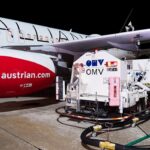
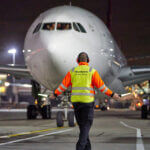
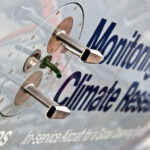


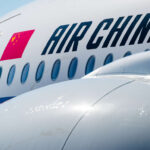
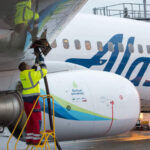
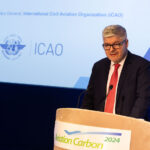
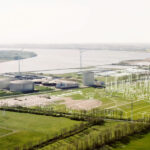
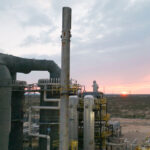

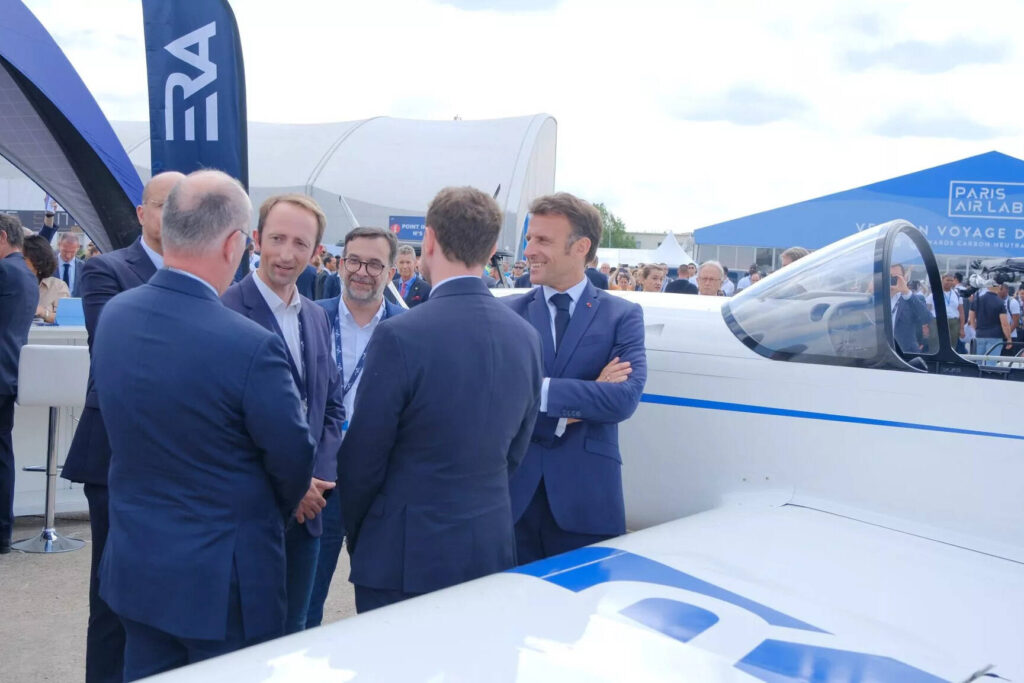

More News & Features
SITA teams with Arab airlines on developing technology to enhance flight sustainability
Alaska Airlines invests in innovative commercial blended-wing body aircraft developer JetZero
US awards $291 million in grants to accelerate low-emission aviation technologies and SAF production and use
Dovetail gets Australian state support and secures seaplane electric conversion deal from Norway
United Airlines’ venture arm adds eight new partners to its $200m Sustainable Flight Fund
Boeing selects Pratt & Whitney and Collins to support new NASA sustainable flight test programme